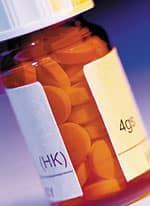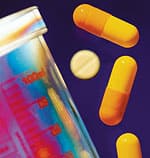Life Extension Magazine®
For centuries, the causes of and cures for migraine have remained unsolved mysteries.1 Many causes have been suspected in the development of migraine,2-4 and this multitude of possible causal agents has led to the development of numerous therapeutic strategies to correct this pathology.5-7 Nevertheless, the stubborn fact is that conventional treatment options cannot consistently cure migraine. After Life Extension published the articles “Case Report: Migraine Solution” (August 2004) and “An Innovative New Treatment for Migraine” (September 2004), the Life Extension Foundation received hundreds of calls from migraine sufferers around the world. People often hope to achieve at least some relief from their headaches, even if a cure remains elusive. Remarkably, however, many who contacted Life Extension and started our integrative program have been delighted to discover that they can be free of migraine and that this debilitating condition can indeed be cured. As noted in our previous reports, we have had excellent results helping migraine sufferers with a program focused on the restoration of neurohormonal and metabolic integrity.8 In this article, we present case studies of three Life Extension Foundation members who suffered from debilitating migraine for eight, 46, and 38 years, respectively. Although each required an individualized treatment program, all three successfully utilized the approach described in Life Extension magazine to become migraine-free.
Case Study #1“MO,” a 47-year-old woman from London, England, presented with an eight-year history of debilitating migraine, which occasionally kept her bedridden for two or three days at a time. She believed that many of her migraines were brought on by “brain stimulation,” and most were accompanied by nausea and vomiting. It was not unusual for her to have a migraine every day during menses. The pain had become so severe in the past few years that MO was forced to quit her job and stay at home, attempting to find a cure. After MO left her high-stress job, she continued to seek medical care to help her “get her life back.” While she consulted many doctors, all they were able to offer to reduce her pain were prescription drugs that produced myriad side effects. MO had also tried intravenous glutathione and vitamin C to promote detoxification in the hope that this would rid her of migraines. In addition to migraine, MO had a history of chronic fatigue syndrome, severe depression, agitation, anxiety with intermittent panic attacks, severe mood swings, sleep disorder, and premenstrual syndrome. She also was occasionally bothered with gas and bloating. Her menstrual cycle was regular, at 28 days. She had not been sexually active for the past few years because of loss of libido, poor sex drive, and vaginal dryness. She was previously diagnosed with osteoporosis and decreased bone density in both hips. MO reported that she had been a vegetarian when she was younger and had a history of low cholesterol. She described herself as anorexic between the ages of 16 and 20, and had suffered bouts of emotional binge eating at other times. Her current height was 5’6” and her weight was 119 pounds. While in her twenties, she used birth control pills for two years and had several breast cysts removed. MO mentioned that she previously had excessive body hair growth, which significantly decreased before the onset of migraine. A gynecological exam did not find any pathology. After reading the Life Extension article about an innovative method of migraine treatment, she contemplated coming to the United States, since she was unable to obtain the necessary supplements, laboratory testing, and bioidentical hormone formulas in her native England. In October 2004, MO traveled to the US for further evaluation and possible management of migraine. In talking with us after her arrival in America, MO said that for years she had felt her hormones were out of balance, which contributed to her symptoms. She had not been able to find any treatment options for rebalancing her hormones, nor could she find any medical options other than pharmacological therapy for relief of migraine. The doctors she consulted refused to do comprehensive hormone testing, saying it was not necessary, and also that their “hands were tied” in the United Kingdom. She was also limited to only the supplements available in her country. We suggested that MO undergo a complete female hormone panel plus a lipid profile. The hormone panel included total estrogen, progesterone, total testosterone, dehydroepiandro-sterone sulfate (DHEA-S), and pregnenolone. Testing was done on day 19 of a 28-day menstrual cycle. The results of initial hormone testing were as follows, with reference ranges in parentheses: total cholesterol: 215 mg/dL (<200); total estrogen: 409 pg/mL (61-437); progesterone: 22.6 ng/mL (0.2-28); total testosterone: 45 ng/dL (14-76); DHEA-S: 62 ug/dL (65-380); and pregnenolone: 216 ng/dL (10-230). At first glance, MO had excellent blood test results, except for low DHEA-S and slightly elevated total cholesterol. The patient’s history of excessive body hair, which had resolved prior to the onset of migraine, was crucial to our understanding the pathogenesis of her migraine and planning an appropriate treatment program. We posited that she had a dominance of androgens until the age of 39, when her migraine started. Based on our clinical experience, we felt that we needed to increase her testosterone to a high-normal level. We aimed to elevate all her hormones, particularly testosterone, as the initial step in our program. The suggested initial program for MO was as follows:
As you can see, we recommended pregnenolone, triestrogen, and progesterone despite the patient’s normal levels of these hormones, as MO’s symptoms suggested that she was in fact clinically deficient in those hormones. Based on our clinical experience with similar patients, we suggested supplemental pregnenolone and progesterone. Also included in her initial program were:
During her first month on the program, MO had no migraines at all. Because of the absence of headaches, particularly during menses, she felt it was a real breakthrough, as this was the first time that had happened in years. She also began to feel much stronger, and acquired more stamina. She was able to be more active without becoming exhausted and developing a migraine. MO reported that she was much calmer and had begun dealing with stressful situations without getting “totally demolished.” She continued, however, to have difficulty sleeping and began to develop slight breast tenderness and occasional bouts of diarrhea. Accordingly, we made slight adjustments to her program. Tri-estrogen was discontinued. Her dose of MetaRest® was increased to two capsules at bedtime. As MO thought she may have contracted stomach flu, MagnaCalm and ProGreens® were discontinued for a few days, and then restarted at the previously suggested doses. MO also started using Douglas Laboratories® RheumaShield™, containing type II collagen (one capsule taken at bedtime), and glucosamine sulfate (2000 mg taken in the morning). Further minor adjustments to her program were made on a weekly basis. After following the program for five months, MO started to work on a part-time basis. She also began to travel and spend time away from home. Thankfully, her life as a recluse is over. After seven months on the migraine program, MO is practically migraine-free. This case was very interesting because of her unusually “good” blood test results prior to treatment. Physicians must remember that a blood test is a valuable additional tool—rather than a primary instrument—for assessing a patient’s condition. Evaluation of the patient’s problem that combines the clinical picture, medical history, and blood testing can help create an individualized program for migraine management.
Case Study #2“KG,” a 58-year-old woman, had suffered migraines for over 46 years, beginning at age 12. She was unable to obtain relief from any of her doctors. After reading the article “An Innovative New Treatment for Migraine” in Life Extension, she called Life Extension health advisors seeking help and more information. Initial contact was made in August 2004. Along with migraine, KG also complained of severe sleep problems and high blood pressure. She had suffered from constipation and digestive problems most of her life. She reported that she and her husband had no intimacy or sex life because of her severe vaginal dryness and lack of libido and sex drive. KG had had a partial hysterectomy at the age of 27 and was placed on an estrogen patch at that time. She had used birth control pills during the five or six years prior to hysterectomy. KG typically experienced up to 10-12 migraines each month, and at times as many as 15-18 monthly. She kept a detailed journal of her long history of migraines, and in the past six years, her frequency of migraine was as follows: 1999: 140 migraines; 2000: 91 migraines; 2001: 98 migraines; 2002: 124 migraines; 2003: 108 migraines; and 2004: 142 migraines. KG reported using many medications. She had recently used Imitrex® for 19 days in a row to get relief from her pain, at times using it twice daily. She was also taking Topamax® for migraine and Benicar® for high blood pressure. KG had been able to isolate only two provoking factors for her migraines. Both monosodium glutamate and red wine usually initiated development of a migraine. KG also had a strong family history of migraine that includes her mother, brother, and niece. At the time of initial evaluation, the 5’6”, 135-pound woman was on a previously implemented regimen of DHEA (30 mg), pregnenolone (50 mg), and an estrogen patch, plus a small amount of progesterone cream (dose and formulas unknown). Initial blood test results were as follows, with reference ranges in parentheses: total cholesterol: 219 mg/dL (<200); total estrogen: 286 pg/mL (61-437); progesterone: 0.7 ng/mL (0.2-28); total testosterone: 47 ng/dL (14-76); DHEA-S: 107 ug/dL (65-380); and pregnenolone: 125 ng/dL (10-230). The following program was suggested:
We also suggested that KG find a doctor who could prescribe tri-estrogen, micronized progesterone, and testosterone gels. Unfortunately, she was unable to find a knowledgeable physician to write prescriptions for bioidentical hormones. Instead of the suggested formula, she obtained a prescription from her doctor for a combination estrogen-progesterone-testosterone topical preparation. Because KG did not feel any improvement, she decided to discontinue use of this preparation. Instead, KG started using topical Pro Fem cream (1/2 teaspoon the first 1-14 days of the month, 1 teaspoon on days 15-25, and 1/3 teaspoon from day 26 until the end of month).
Less than one month after starting her program, KG called to report that her sleep and digestion had improved, and that the severity and volume of her migraines had decreased. Over the course of the next few months, there was little contact from her. She again began using several different hormone formulas from whichever doctors were willing to write her a prescription, and did not use the other suggested supplements. We received another call from KG in January 2005. She stated that she had finally obtained hormone formulas that were very close, though not identical, to the ones we had previously suggested. She reported that after applying them cyclically for a short period, she had been free of migraine for eight days. She was excited and encouraged for the first time in years. KG was now ready to do some serious work and begin a personal regimen to become migraine-free, once and for all. At this time, we made slight changes to the program previously described. She began taking triestrogen (90% estriol, 7% estradiol, 3% estrone) and micronized progesterone (50 mg/mL) gels on a cycle, and micronized testosterone (50 mg/mL) gel, as described in the Life Extension article. Because of severe vaginal dryness and no libido, she was also placed on Life Extension Natural Sex for Women (two tablets in the morning and two in the evening) and the herb Tribulus (Tribulus terrestris, 450 mg, two tablets in the morning).
KG called back three weeks later to report that she had no sleep or digestive problems, had plenty of energy, and her vaginal dryness had lessened. The best news was that she had no migraine. At last contact with her, she had gone almost six weeks without a migraine. Furthermore, red wine did not trigger her migraine anymore. This case is interesting in that KG had been a member of the National Headache Foundation for many years. She had tried many recommendations and new methods of relief described in their newsletters, but her problem persisted. Unexpectedly, she obtained help from the Life Extension Foundation that solved her migraine problem. She was quite surprised to see that the latest National Headache Foundation newsletter (May/June 2005) raised issues about the regimen described in Life Extension magazine. The newsletter featured a skeptical response from an osteopathic physician stating that there is no foundation for such a program. Furthermore, the DO’s statement failed to note that all the patients described had experienced a total cessation of their migraine. This very program had cured KG’s migraine. KG stated that whenever she had read the National Headache Foundation newsletter in the past, she got “depressed reading it, or frightened, because there never seemed to be any real hope for anyone.” Due to the newsletter’s dismissive response to a valid question with substantial evidence from a credited professional, KG reports that she will cancel her newsletter subscription and National Headache Foundation membership, and that she will “tell them why.” | ||||||
Case Study #3“MM,” a 56-year-old woman with a long history of migraine, called us in January 2005. She experienced her first headache almost 38 years ago, at the age of 18. MM also complained of depression, problems sleeping, hypertension, weight gain, severe hot flashes, significantly decreased sex drive and libido, and muscle aches. MM was experiencing a migraine every day. One of her common headache triggers was a change in the weather. She also reported at times waking up with pounding headaches at 2-2:30 a.m.
She had experienced premenstrual syndrome at a relatively young age. Since the age of 35, MM had gained more than 20 pounds. Her current weight was 187 pounds, her height 5’2”. She had a history of two normal pregnancies and five abortions. During her pregnancies, she had practically no migraine. Her menses stopped at age 52. Four years ago, a doctor discovered that MM had elevated blood pressure (150/95 mm Hg) and very high cholesterol (above 300 mg/dL). MM was placed on nadolol for hypertension and Lipitor® for hypercholesterolemia. Because of adverse side effects from taking Lipitor®, this drug was discontinued after two months of treatment. MM was taking different painkillers on a daily basis. After receiving information about a migraine program from a Life Extension health advisor, a required blood test was performed by a family physician. Blood test results were as follows, with reference ranges in parentheses: total cholesterol: 300 mg/dL (<200 mg/dL); estradiol: 19 pg/mL (19-528); progesterone: 0.4 ng/mL (0.2-28.0); total testosterone: 51 ng/dL (14-76); DHEA-S: 86 ug/dL (65-380); and pregnenolone: less than 10 ng/dL (10-230). MM’s medical history, physical appearance, and blood test information suggested the following program:
We also recommended zinc (30 mg), MetaRest® (one capsule), and MagnaCalm (one scoop), all taken at bedtime. We likewise suggested that she request the following prescriptions from her doctor: triestrogen (90% estriol, 7% estradiol, 3% estrone) gel and micronized progesterone (50 mg/mL) gel, to be used on a cyclical basis. After six weeks on the program, MM reported back to us that she was free of migraines. She had stopped taking medicine for headaches, reported increased energy, was enjoying a fulfilling sex life with her husband, and stated that she “feels great.”
CommentaryIn this article, we have described three cases that required three different approaches. In the first case, we used a very specific, individualized approach. The patient’s clinical picture played a major role in this case. If we had relied only on blood test results as a determining factor, we could not have achieved a successful migraine cure. In the second case, our patient sought to modify in her own way the migraine-correction program we recommended. She substituted supplements (for example, using a combination of melatonin and L-theanine instead of MetaRest®), used different hormone preparations, did not apply the hormone preparations cyclically, and was inconsistent in her usage of the program. When she finally realized that it is not only the particular hormones and supplements that play a main role in migraine management—and that it is crucial to use certain formulas and combine them with specific regimens (i.e., taking them at certain times of day and in cyclical fashion)—she was able to get complete relief from migraine. In other words, how she used the different preparations and supplements proved to be extremely important. The third case was typical in clinical picture, blood test results, and approach for management. By strictly following the program, the patient achieved the expected end result: a life without migraine headaches after 38 years of suffering. As you can see, all three programs for curing migraine were similar, with small variations as necessitated by each individual’s requirements. | ||
| References | ||
2. Aurora SK. Etiology and pathogenesis of cluster headache. Curr Pain Headache Rep. 2002 Feb;6(1):71-5. 3. Sinclair S. Migraine headaches: nutritional, botanical and other alternative approaches. Altern Med Rev. 1999 Apr;4(2):86-95. 4. Landy SH. Challenging or difficult headache patients. Prim Care. 2004 Jun;31(2):429-40, viii. 5. Lawrence EC. Diagnosis and management of migraine headaches. South Med J. 2004 Nov;97(11):1069-77. 6. D’Amico D. Treatment strategies in migraine patients. Neurol Sci. 2004 Oct;25 Suppl 3S242-3. 7. Sandor PS, Afra J. Nonpharmacologic treatment of migraine. Curr Pain Headache Rep. 2005 Jun;9(3):202-5. 8. Dzugan SA, Smith RA. The simultaneous restoration of neurohormonal and metabolic integrity as a very promising method of migraine management. Bull Urg Rec Med. 2003;4:622-8. |








